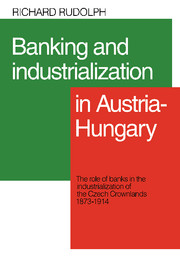 Banking and Industrialization in Austria-Hungary
Banking and Industrialization in Austria-Hungary Published online by Cambridge University Press: 05 January 2012
The purpose of the next two chapters is to take a closer look at the relationship of financial institutions to individual branches and firms, particularly in the period after 1873. The present chapter deals primarily with the activities of the Vienna-centered banks, while chapter 5 deals with banks located within the Czech Lands. Before going into a micro-level examination, however, it is useful to take a brief overview of the major currents in bank-industry relations throughout the nineteenth and early twentieth century.
From such a macro-economic or macro-historical viewpoint, there were four major periods in the development of the relationship between banks and industry:
1800–53
In this period the capital market was dominated by the National Bank and a few private banking houses. As indicated in the preceding chapter, these banks had little to do with industry. At the same time the capital market as a whole was poorly developed. While in some instances credit was granted by the large banks to aristocrats involved with mining or manufacture on their own lands, both short and long-term credit remained outside the reach of almost all small manufacturers. In several cases the government sought in vain to procure assistance from the banks for a projected joint stock steam engine company, and finally was itself forced to intercede with financial aid. Prior to the 1850s there was little industrial promotion; the few joint stock firms of this period were usually formed by families, or by small groups of business associates, rather than through shares placed upon the market.
To save this book to your Kindle, first ensure [email protected] is added to your Approved Personal Document E-mail List under your Personal Document Settings on the Manage Your Content and Devices page of your Amazon account. Then enter the ‘name’ part of your Kindle email address below. Find out more about saving to your Kindle.
Note you can select to save to either the @free.kindle.com or @kindle.com variations. ‘@free.kindle.com’ emails are free but can only be saved to your device when it is connected to wi-fi. ‘@kindle.com’ emails can be delivered even when you are not connected to wi-fi, but note that service fees apply.
Find out more about the Kindle Personal Document Service.
To save content items to your account, please confirm that you agree to abide by our usage policies. If this is the first time you use this feature, you will be asked to authorise Cambridge Core to connect with your account. Find out more about saving content to Dropbox.
To save content items to your account, please confirm that you agree to abide by our usage policies. If this is the first time you use this feature, you will be asked to authorise Cambridge Core to connect with your account. Find out more about saving content to Google Drive.